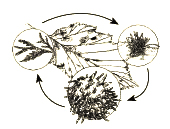Blog
Juniper-Hawthorn Rust
Defend Juniper from Fungal Attacks
 Plant diseases show their faces in a variety of ways, some stranger than others. Perhaps you’ve noticed orange jelly-like balls on juniper branches in the spring of the year. Consider the disease, juniper-hawthorn rust, also known as cedar-apple rust. The fungus that causes this disease will produce orange jelly-like balls on juniper branches. This orange gelatinous material, which contains thousands of spores, oozes out of chocolate-coloured galls present on affected branches. Spores are then carried by the wind to the pathogen’s alternate host. That’s where the hawthorn or apple comes in.
Plant diseases show their faces in a variety of ways, some stranger than others. Perhaps you’ve noticed orange jelly-like balls on juniper branches in the spring of the year. Consider the disease, juniper-hawthorn rust, also known as cedar-apple rust. The fungus that causes this disease will produce orange jelly-like balls on juniper branches. This orange gelatinous material, which contains thousands of spores, oozes out of chocolate-coloured galls present on affected branches. Spores are then carried by the wind to the pathogen’s alternate host. That’s where the hawthorn or apple comes in.
The causal fungus must have two hosts to complete its life cycle. Symptoms on the alternate host are very different than on junipers. Greenish yellow spots will appear in June on the leaves of hawthorn, mountain ash, apples, crabapples or other alternate hosts. Spores produced on these leaves then blow back to the juniper or cedar, and the cycle starts all over again. The disease cycle is two years: 18-20 months on juniper and 4-6 months on the alternate host.
Control
To control this disease:
- Separate the hosts. The rust fungus cannot survive in the absence of one of the hosts.
- Remove rust galls. Juniper galls and the resulting orange gelatinous extrusions (above) should be pruned out in late winter or early spring.
- Fungicide sprays also are available but seldom are necessary.
Contact us today to learn more or get started.
Source: My Garden Patch

